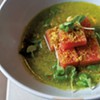Published December 3, 2008 at 6:04 a.m.
Strolling the aisles of Burlington’s first-ever Winter Farmers’ Market last month, hundreds of shoppers selected fruit tarts, cuts of meat, cheeses and the season’s last frilly heads of red and green leaf lettuce. Many seemed to find the selection of cold-hearty root vegetables less enticing, despite the rainbow of colors on display. State Rep. David Zuckerman, owner of Full Moon Farm, said he expected to sell out of everything except a big tote filled with purple-tinged rutabagas.
Why were the sweet and earthy rutabagas left behind? Why do so many owners of winter farm shares groan when they find another bag full of dirt-encrusted lumps? Perhaps because root vegetables aren’t the best-known or most accessible treats: Just ask the average home cook to tell the difference between a rutabaga and a turnip. Or to name 10 easy ways to prepare parsnips.
If those quandaries aren’t enough of a deterrent, consider the celeriac, which may be the least attractive subject of the root vegetable kingdom. Hairy and gnarled, with dirt clinging to their numerous nooks and crevices, celeriac are difficult to clean and peel, assuming you even know what they are. Confronted with these warty specimens, a shopper might just turn and run.
But a root novice who rises to the challenge will find delicious, celery-like flavor in a better-textured package. In fact, celeriac is a perfect addition to any dish that calls for its stringy, watery cousin: Think bread stuffing, soup or slaw.
We think roots are tops, so we’ve put together a guide to selecting and storing five you’ve probably seen, but may not know how to handle. Carrots didn’t make the list because, frankly, we figure you’re all set with those.
Selection:
All roots should be firm and heavy for their size, without discoloration or soft spots. If it’s wrinkled, don’t buy it. Small to medium roots generally taste better than their massive counterparts.
Sometimes beets, turnips and rutabagas come with leaves attached. This is great, because such leaves are edible and nutritious. They should be bright green and healthy looking.
Storage:
Any leaves should be removed and stored separately; they can suck the moisture out of the roots. Roots are best stored without washing and do well in cool, dark places. (Between 32 and 40 degrees is best.) For extended storage, unless you have a root cellar, wrap them loosely in plastic and put them in your fridge’s “crisper” drawer.
******
ROOTING OUT THE SPECS
Beets
Beets, which are closely related to chard, spinach and quinoa, come in a variety of colors: Although most are red, you can also find white, golden, pink and colorful bull’s-eye-patterned specimens. The juice stains, so be cautious when peeling or chopping them.
Nutrition:
Beets are higher in sugar than any other vegetable, but they’re also packed with nutrients. A one-cup serving of raw beets has just 58 calories and ample portions of vitamin C, iron and magnesium. It also contains a hefty dose of dietary fiber, folate, potassium and manganese.
Trivia:
- In his novel Jitterbug Perfume, Tom Robbins calls beets “the most intense of vegetables” and “the melancholy vegetable, the one most willing to suffer. You can’t squeeze blood out of a turnip . . . ”
- The Romans considered beet juice an aphrodisiac.
- President-elect Obama doesn’t feel the love. Beets are one of his least favorite foods.
- The ancient Romans used the leaves of the beet plant for medicinal purposes, but not the roots. Pliny shunned them as “those scarlet nether parts.”
- The juice is used as rouge in Russia.
Celeriac
Try to select smoother celeriac rather than knobby ones, so as not to waste as much when trimming.
To prepare a celeriac for cooking, chop off the rooty-looking end and peel the remainder. Deep pockets of dirt can be excised with a paring knife or the tip of a vegetable peeler.
Nutrition:
High in fiber, this veggie is a good source of vitamin B6, magnesium and manganese, and an excellent source of vitamins C and K, potassium and phosphorus. A cup of raw celeriac has 66 calories.
Trivia:
- Because celeriac stems are hollow, they are sometimes cut to straw length and used to suck up Bloody Marys.
- It’s also referred to as “celery root,” “soup celery,” “turnip-rooted celery” and “knob celery.”
- Céleri rémoulade may be the most famous celeriac dish. Thin strips are covered in a sauce made from mayonnaise, herbs, and capers or mustard.
- Contrary to what you may read on the Internet, celery root is not simply the root of the plant that we call celery, although the two are closely related.
- Like many root vegetables, celeriac is thought to be an aphrodisiac. Legend has it that famed consort Madame du Barry regularly served her lover, King Louis XV, a soup made from the gnarled root.
Parsnips
Parsnips look like carrots that have had the wind knocked out of them. Pale, fibrous and thick skinned, they should be peeled before eating.
Nutrition:
Although they have less sugar than beets, these pale, sweet-tasting roots are higher in calories, at 100 per raw cup. Luckily, that same serving size delivers a whopping dose of vitamin C and 37 percent of the recommended daily allowance of vitamin K. In addition, parsnips are a good source of potassium and a great one of dietary fiber, folate and manganese.
Trivia:
- Although the word “parsnip” sounds like a nifty combination of “parsley” and “turnip,” the name actually stems from the Latin word for a two-pronged fork.
- Poison hemlock is a close relative of the wild parsnip, and one is easily mistaken for the other. So unless you’re a knowledgeable forager, don’t try to harvest parsnips in the wild.
- Before the introduction of potatoes to North America, parsnips were much more common in cuisine than they are today.
- Parsnips grow best in cool climates with shorter growing seasons, making them a perfect Vermont crop. They taste best when left in the ground until the temperature approaches freezing.
- Parsnip wine is a favorite in Britain.
Rutabagas
The humble, yellow and purple rutabagas used to be less obscure than they are today. But their great flavor and nutritional content are bringing them back in vogue.
Nutrition:
Earthy and sweet, a single cup of raw rutabaga delivers a whopping 58 percent of your daily vitamin C requirement and a hearty helping of calcium. The rutabaga is no slouch when it comes to thiamin, vitamin B6, folate, magnesium, phosphorus, potassium or manganese, either. One raw cup contains 50 calories.
Trivia:
- There’s a reason rutabagas look a lot like turnips. Botanists believe they are a cross between turnips and cabbages that originated in the Middle Ages.
- The name comes from the Swedish word rotabagge, which means “round root.” They’re so popular in Sweden that Brits call ’em “Swedes.”
- Ithaca, New York, holds an annual “rutabaga curling” championship, patterned after the Olympic ice sport, which regularly draws more than 100 contestants. No turnips allowed.
- Before pumpkins were commonly carved to make jack-o’-lanterns, folks took knives to their rutabagas and turnips and filled the hollows with glowing embers. These were intended to scare away evil spirits.
- Famed Chicago poet Carl Sandburg penned a volume of children’s tales titled Rootabaga Stories and a sequel called Rootabaga Pigeons. Many take place in the village of “Liver and Onions.”
TURNIPS
Whiter than rutabagas, turnips are a little less sweet and have a hint of radish-like heat. Baby turnips, grown by several area farmers, are sweeter and have less bite than the bigger varieties.
Nutrition:
The lowest calorie contender of all our roots, at 36 per raw cup, turnips are great for folks working on healthy weight loss. The wonder veg is blessed with a great deal of vitamin B6, folate, calcium, potassium and copper, and it’s chock-full of vitamin C and manganese.
Trivia:
- In Scotland, turnips are considered a natural accompaniment to haggis. When mashed, they’re referred to as “bashed neeps.”
- Although he wasn’t a fan of beetroots, Pliny the Elder was hot for turnips. He said the root’s “utility surpasses that of any other plant.”
- Goethe liked them, too, but preferred them when “mixed with chestnuts.”
- The Gilfeather turnip, one of Vermont’s two registered heirloom varieties, is native to the tiny town of Wardsboro. Residents are so proud of their turnip that they throw a festival in its honor each October and have commemorated it in verse and song.
- Like to play with your food? A simple web-based game called “Turnips” gives players points for matching the roots based on color and number of leaves. Rotten ones decrease your score.
******
ROOT RECIPES
Gratin of Beets and Apples with Goat Cheese and Horseradish
by Steven Obranovich, Chef-Proprietor of Claire’s Restaurant & Bar in Hardwick
This recipe can be made with a combination of any root vegetables, such as celery root, parsnips, rutabagas or turnips. Be experimental and try other cheeses in place of goat, such as Bonnieview’s Coomersdale or Jasper Hill’s Constant Bliss. The last caveat for this dish is that the horseradish is essential, as are the nuts. Enjoy as a side dish, or form individual gratins to start a meal. Either way — just eat your beets!
Ingredients:
- 3 pounds beets (Look for Chioggia, gold and white ones from Pete’s Greens.)
- 1/4 cup apple cider vinegar
- 12 apples, cut off the core and diced small (no need to peel)
- One stick of butter
- 2 cups apple cider (Try to find it unpasteurized from a farm stand.)
- 12 oz. goat cheese
- 1 1/2 tablespoons salt
- 1 tablespoon each pepper and nutmeg, freshly ground
- 2 tablespoons rosemary and thyme, picked and chopped fine
- 1/2 cup fresh horseradish, peeled and grated on a box grater or Microplane, or chopped fine in a food processor
- 1 cup heavy cream (Try Butterworks.)
- 3/4 cup whole milk
- 1/2 cup bread crumbs (Great use for leftover pieces of bread; tear into small pieces and process in a food processor until fine.)
- 1/2 cup hazelnuts or walnuts, toasted, roughly chopped, and combined with the bread crumbs
- 4 tablespoons butter
- Preheat oven to 350 degrees.
- Place beets in pot, cover with water, and bring to a boil. Reduce heat, partially cover, and simmer for 20 to 30 minutes, or until tender when poked with the tip of a knife. Drain, cool, and peel. Cut into wedges and, while still warm, drizzle with the vinegar and set aside.
- Place the butter in a couple of larger sauté/frying pans over high heat. When the butter has just begun to brown, add the apples and sauté, stirring often. When the apples begin to dry out and brown, add half the cider and continue to stir and cook for two minutes. Reduce heat to medium. Repeat with remaining cider and continue to stir. Remove from heat and combine with beets.
- In a bowl, combine the cream, milk, salt, pepper, nutmeg, horseradish and herbs. Stir. Take the wrapper from a stick of butter and shmear it around a casserole dish. Add beets and apples and crumble the goat cheese over them. Next pour on the cream mixture, sprinkle with the nutty crumbs, and dot with butter. Put the gratin dish on a cookie sheet to catch any drips and cook for 30 to 40 minutes, or until bubbling with nicely browned crumbs.
Celery Root Soup
by Jason Tostrup, Executive Chef of the Inn at Weathersfield
Ingredients:
- 4 cups celeriac, aka celery root, peeled and diced
- 3 cups onions, diced
- 2 cups celery, diced
- Four to five cloves garlic, chopped
- 2 tablespoons butter
- 2 tablespoons olive oil
- 2 quarts chicken or vegetable stock
- One herb bouquet, consisting of thyme, sage and rosemary tied together in a coffee filter
- Fresh chives, chopped
- Salt and pepper
- Using a heavy-bottomed soup pot over medium heat, add olive oil, butter, onion, celery and garlic. Sauté until onions have become limp and translucent.
- Add celery root and stock, bring to a simmer, and add herb bouquet. Season with salt and pepper.
- Once vegetables are soft, remove the bouquet, making sure to squeeze all the flavor from the herbs.
- In small batches, place soup in a blender and puree.
- To finish, season with fresh chopped chives and cracked black pepper.
Vermont Roasted Roots
by Jamie Eisenberg, Executive Chef of Healthy Living
Root Ingredients:
- 3 cups parsnips, peeled and cut into 1-inch rounds
- 3 cups beets, diced large
- 3 cups carrots, peeled and cut into rounds diagonally
- 2 cups sweet potatoes, peeled and diced large
- 1/4 cup vegetable oil
- Salt and pepper to taste
- 1/4 cup maple syrup
- 2 tablespoons tamari
- 2 tablespoons cider vinegar
- 1 tablespoon Dijon mustard
- 1 tablespoon ginger
- 1 tablespoon garlic, minced
- Toss the parsnips with vegetable oil, salt and pepper. Spread on a cookie sheet.
- Repeat with carrots, beets and sweet potatoes, and roast at 400 degrees until tender. If you don’t have the oven space to use four separate cookie sheets, combine the parsnips, carrots and sweet potatoes. Beets should be roasted separately.
- Pour marinade over each sheet pan and toss the vegetables slightly. Roast until the marinade is absorbed and the vegetables are glazed.
- In a serving bowl, mix all together and season with salt and pepper, as needed.
- Four large carrots, peeled and cut into 1-inch chunks
- Two rutabagas, peeled and cut into 1-inch chunks
- 4 tablespoons butter, divided
- 1/4 teaspoon fresh grated nutmeg
- Salt and pepper
- Put the carrot and rutabaga chunks into a 4-quart pot of cold water and add 1 tablespoon salt. Bring to a boil, reduce heat to medium low, and simmer for 20 minutes. The vegetables are done when you can easily pierce them with a fork.
- Set up a colander over a bowl and pour in the veggies and water.
- Return the veggies to the pot and mash roughly with a potato masher or a large fork. Stir in 3 tablespoons butter and the nutmeg. Add salt and pepper to taste.
- Put into a serving bowl and top with the remaining tablespoon of butter.
- One bunch radishes (about 8 to 10)
- One bunch hakurei turnips (about 8 to 10)
- 1/4 cup fennel leaves, chopped
- 1/2 teaspoon coarse sea salt
- 1/2 teaspoon black pepper
- One garlic clove, minced
- 1/4 cup olive oil
- 1 teaspoon orange zest
- 1 tablespoon honey or maple syrup
- Juice of a lemon and orange, about 1/4 cup total
- Wash turnips and radishes thoroughly. Don’t peel.
- Wash and finely chop fennel leaves.
- Slice turnips and radishes very thinly and arrange attractively on a platter.
- Sprinkle a little of the sea salt on the roots.
- Prepare dressing. In a bowl, combine the salt, pepper, garlic, olive oil, orange zest, honey or maple syrup, and juices. Whisk until the dressing is emulsified. Drizzle over the roots.
- Garnish with the fennel.
- May be made up to 30 minutes before serving. Store in refrigerator until ready to serve.
Marinade Ingredients:
Makes 12 servings.
Carrot and Swede Mash
by Robin McDermott of the Mad River Valley Localvore Project
This is a very English dish that I first heard about from friends who lived in the U.K. for a couple of years. “Swede” is the British name for rutabaga. The vegetables are roughly mashed, leaving 1/4-inch chunks, although if you prefer, you can make a smoother mash.
Ingredients:
Turnip, Radish and Fennel Leaf Salad with Lemon-Orange Dressing
by Mara and Spencer Welton of Half Pint Farm
Ingredients:
More By This Author
Speaking of...
-

A Multilayered Career Leads a Seasoned Chef to Middlebury’s Swift House Inn
Mar 12, 2024 -

Swedish Cinnamon Rolls: A Recipe for 'Kanelbullar'
Mar 12, 2024 -

Q&A: Howard Fisher Delivers Meals on Wheels With a Side of Good Cheer
Dec 20, 2023 -

Video: Howard Fisher Delivers Meals on Wheels
Dec 14, 2023 -

Mealtime: Greek-Style Lamb Chops
Nov 14, 2023 - More »
Comments
Comments are closed.
From 2014-2020, Seven Days allowed readers to comment on all stories posted on our website. While we've appreciated the suggestions and insights, right now Seven Days is prioritizing our core mission — producing high-quality, responsible local journalism — over moderating online debates between readers.
To criticize, correct or praise our reporting, please send us a letter to the editor or send us a tip. We’ll check it out and report the results.
Online comments may return when we have better tech tools for managing them. Thanks for reading.














































